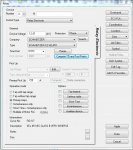AHarb
Member
- Location
- Atlanta, GA
Hi,
I'm trying to verify that our circuit breakers coordinate with the substation bank protection by plotting the curves of each. We are sent data sheets with the protection settings from our transmission provider, but it seems like I'm missing a "time dial" setting when I try to plot the curve in CymeTCC. Is there a way to derive the time dial settings from the settings given (see image) or do I need more information from our transmission provider to plot the curves?

Thanks
I'm trying to verify that our circuit breakers coordinate with the substation bank protection by plotting the curves of each. We are sent data sheets with the protection settings from our transmission provider, but it seems like I'm missing a "time dial" setting when I try to plot the curve in CymeTCC. Is there a way to derive the time dial settings from the settings given (see image) or do I need more information from our transmission provider to plot the curves?

Thanks


